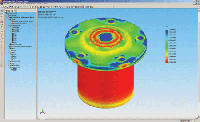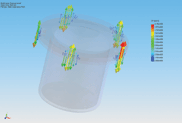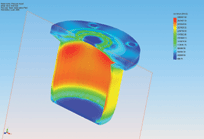Latest News
October 1, 2004
By Sanjeev M.Kulkarni
The tagline behind the marketing of COSMOSWorks 2005 is “Design Analysis MadeSimple.” It’s a punchy motto that also holds true for this latest release of theCOSMOS analysis product from Structural Research and Analysis Corp. (SRAC).
In fact, the three main steps in a typical FEA (finite element analysis) study—preprocessingor model development, processing or numerical solution, and postprocessing orresults visualization—appear to be quite seamless in SRAC’s latest offering. Further,COSMOSWorks 2005, which was released this past August, holds its own in the developer’schosen market space—namely SolidWorks users who want to quickly check the integrityof their designs and then search for the optimum solution. Dassault Systemes,parent company to SolidWorks and SRAC, made customer and user feedback the basisfor this latest release. Rigorous discussions with their user base resulted inthree major developmental themes for 2005: 1) achieving a tighter integrationwith SolidWorks (Dassault’s CAD solution), 2) simplifying the analysis processfor design engineers, and 3) including expanded analysis capabilities for experiencedusers. The net effect is that the latest version contains more than 100 individualcustomer-centric enhancements. We took a look at the latest release and will examineeach of these three major themes separately.
 Figure 1: This Factor of Safety plot shows a simple-to-use interface with toolbarsand familiar icons. Tighter integration of COSMOSWorks with SolidWorks significantlyreduces the learning curve.
Figure 1: This Factor of Safety plot shows a simple-to-use interface with toolbarsand familiar icons. Tighter integration of COSMOSWorks with SolidWorks significantlyreduces the learning curve.
The initiative to tighten the integration of COSMOSWorks 2005 with SolidWorkswas implemented to significantly reduce the learning curve for the design analyst.This manifests in several ways:
- Complete bidirectional associativity with the active SolidWorks configuration
- A QuickTips feature that serves as a context-sensitive analysis process aid
- Toolbars and icons with a Windows XP look
- A Property Manager-style interface
- SolidWorks-style analysis tutorials
- Context-sensitive menus and customizable symbols for loads and restraints
- Improved visualization (section and isoplots using SolidWorks defined clippingplanes).
Specific features and applications have been added to the software to make lifeeasier for the design engineer. Among them are Drop Test; Bolted Connections;a seamless interface with COSMOSMotion and COSMOSFloworks, two of SRAC’s othersoftware offerings; Connectors; and a framework to compare simulation resultswith test data.
The Bolted Connections feature is useful, but is also offered by several otherproducts across the spectrum. On the other hand, the ability to compare analysisand prototype test results appears to be quite unique (especially regarding theability to import channel data from a physical test). We found that the Drop Testand Connectors features, though helpful, have some limitations. The Drop Testfeature addresses the inertial, damping and impact issues, but does not accountfor the high strain (loading) rate dependency of the material properties. As faras connectors go, only a few types are offered. (More connector types are probablyincluded in the COSMOSMotion product.) To be fair, both strain rate effects aswell as more connector types with deformable structures are quite complicatedand are typically offered only in high-end packages such as ABAQUS and DYNA. Overall,however, all the features listed above are quite impressive.
To take a different look at the thesis of simplifying analysis process, we triedto complete a calculation using one of the pressure-vessel solid models from SolidWorks.The three main steps in a typical calculation—meshing and applying loads and constraints,static loading solution, and results processing and visualization—went rapidlyfor a first-time COSMOSWorks simulation. Figure 1 (see page 38) illustrates theFactor of Safety plot while Figures 2 (below) and 3 (see page 40) show the ContactPressures and the von Mises Stress section plot for this review, respectively.One feature should be singled out: the Yield Indicator (an arrow indicating theyield strength in the stress legend) is a great little benefit.
 Figure 2: The three main steps in a typical calculation went quite rapidly fora first-time COSMOSWorks simulation. Here, the analysis shows Contact Pressuresduring the loading phase of the calculation.
Figure 2: The three main steps in a typical calculation went quite rapidly fora first-time COSMOSWorks simulation. Here, the analysis shows Contact Pressuresduring the loading phase of the calculation.
Expanded Capabilities for Experienced Users Experienced users of COSMOS will also find some expanded capabilities to sinktheir teeth into. These capabilities include nonlinear analysis, fatigue calculations,expanded thermal analysis, and mesh diagnostic tools. While these capabilitiesare an enhancement within COSMOSWorks, significantly advanced versions of eachof these categories are offered individually or in combination in several high-endsoftware packages and suites (i.e., ABAQUS, ANSYS, SAFE, and HYPERWORKS, to namea few). On the other side, cost is definitely a factor and it appears that expandedcapabilities offered within COSMOSWorks 2005 are a great value. COSMOSWorks offersthree different flavors of the software, Designer, Professional, and AdvancedProfessional.
 Figure 3: The von Mises Stress section plot above for this calculation was aneasy and fast step.
Figure 3: The von Mises Stress section plot above for this calculation was aneasy and fast step.
Some Limitations and Verdicts
As the nonlinear analysis snob that I am, and in comparing COSMOSWorks with thehigh-end packages, 2005 has limitations when it comes to the number and typesof elements offered, scripting/customization, and general nonlinear contact (finitesliding, friction, self-contact). But in its defense, users of such advanced featuresand capabilities are not the primary audience for this product.
When taken together and considered from the point of view of a SolidWorks customerwho intends to perform design analysis quickly, the package is quite capable andpowerful for its price. And we were pleasantly surprised by the short learningcurve. Overall, COSMOSWorks 2005 gets a thumbs up.
Sanjeev M. Kulkarni, Ph.D., is the president of KB Engineering, a design and analysis consulting firm specializingin nonlinear finite element simulations based in Tempe, Arizona. You can contacthim about this article via e-mail to Desktop Engineering Feedback.
Company InformationSRAC/SolidWorks Corp.
website
Subscribe to our FREE magazine, FREE email newsletters or both!
Latest News
About the Author
DE’s editors contribute news and new product announcements to Digital Engineering.
Press releases may be sent to them via [email protected].






